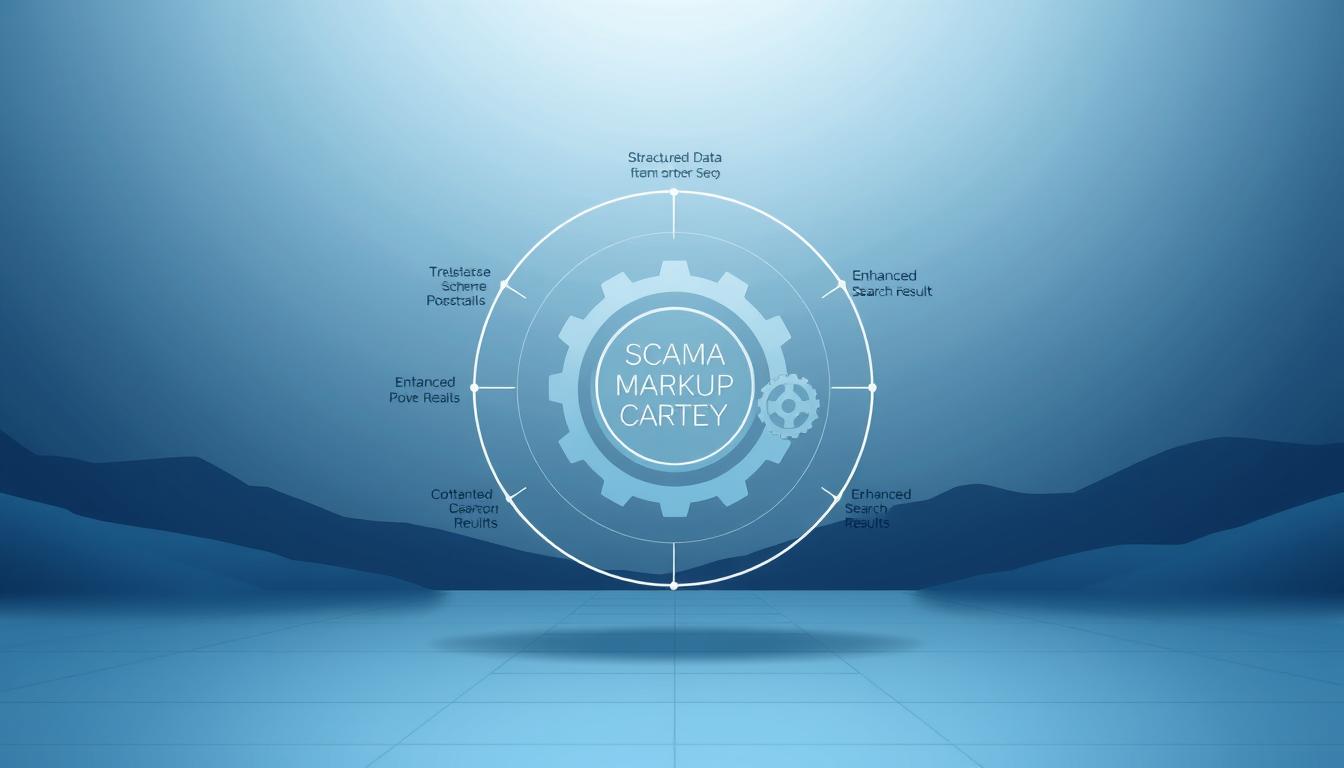In today’s fast-changing digital world, schema markup is key for Chief Marketing Officers to boost their online presence. The CMO Guide To Schema offers a detailed guide on using structured data. It helps improve search engine visibility and engage users better.
Now, schema markup is more than just a technical SEO boost. It’s a smart way to share complex business info with search engines. This makes content smarter and more precise.
Websites using schema markup see big wins, like a 30% jump in click-through rates. This powerful method helps businesses shine in the digital market. It offers rich, detailed info that grabs user interest.
Key Takeaways
- Schema markup dramatically improves search engine understanding of website content
- Strategic implementation can increase organic traffic and user engagement
- Rich snippets generated through schema attract more user clicks
- Schema supports advanced SEO strategies across enterprise-level websites
- Structured data helps align content with user search intent
Understanding Schema Markup Fundamentals
Understanding the digital world is key. Tools like structured data help search engines get website content. This makes the web smarter.
Digital marketing today needs smart strategies. Semantic SEO and schema markup are key. They help businesses show their value to search engines.
What is Structured Data and Why It Matters
Structured data is like a secret language for search engines. It helps them understand website content well. Here are some important points:
- 40% of Google searches look for schema data
- Using structured data can increase website traffic by up to 20%
- Rich snippets can make people click on search results 30% more
The Role of Schema in Modern SEO
Schema markup goes beyond just keywords. It turns content into organized, easy-to-understand information. This helps search engines show it better.
Core Benefits for Enterprise Organizations
Big companies get big benefits from schema:
- More visibility in search results
- Better user experience
- More accurate content display
- Potential ranking boosts
Using structured data makes a business’s online presence smarter. It talks to search algorithms and potential customers better.
Maximizing Rich Results Through Strategic Implementation

Rich snippets have changed how we see search engine visibility. Today, Google offers 32 types of rich results. This gives businesses a chance to really stand out in search results. Using schema markup well can greatly improve how well you show up in search results.
Companies have seen big wins from using structured data. For example:
- SAP saw a 400% jump in clicks from rich results
- Sharp Healthcare got an 843% increase in clicks in nine months
- Pages with schema markup get 2.7 times more organic traffic
Rich snippets add important visual details that grab user attention. They show things like star ratings, prices, and availability right in search results. These visual cues make a big difference in click-through rates, with rich results getting 58% of all search result clicks.
Choosing the right rich result types is key to a good schema markup strategy. In 2023, product, review, and FAQ rich results were the most common. Businesses should pick structured data that matches their content and what users are looking for.
By using schema markup, companies can share complex information clearly. This helps search engines show their brand and content accurately. The outcome? Better visibility, more user engagement, and possibly more conversions.
CMO Guide To Schema: Building Your Semantic Layer
The digital world is changing fast. Marketers need to move past old keyword tricks. They must use schema markup to build a semantic layer for better online presence.
Search tech is moving from just matching keywords to understanding how things relate. This change means marketers need a new way to create and mark up content.
Shifting from Keywords to Entities
Entity recognition is a big change in search optimization. Marketers now focus on:
- How content relates to each other
- The meaning of digital stuff in context
- How topics are connected semantically
Creating a Content Knowledge Graph
Knowledge graphs help build big, connected content systems. With smart schema markup, companies can:
- Help search engines get what they’re about
- Make content easier to find
- Give users better digital experiences
Entity Recognition and Linking
Good entity recognition links different content parts together. Advanced CMO Guide To Schema strategies suggest strong linking. This helps search engines get complex content networks.
Having a smart semantic layer gets companies ready for AI search. It makes sure their content stays found and useful in a smarter digital world.
Schema Markup Deployment Best Practices
Deploying schema markup well needs a smart plan. It changes how search engines see your online stuff. With so many searches every day, using structured data is key for businesses to stand out online.
When you start using schema markup, there are important steps to follow:
- Choose JSON-LD as your main markup format, as Google suggests
- Make sure to cover all types of website content
- Use Google’s tools to check if your markup works
- Make sure the schema you use is accurate and relevant
Using schema markup right can really help your website. Studies show sites with structured data can rank higher in search results. This means more people might find and click on your site.
For even better results, try these advanced schema strategies:
- Get your content entities right
- Build detailed knowledge graphs
- Use different types of structured data
- Keep your markup up to date
Experts using the latest schema techniques can make your online presence shine. Your content will be easier to find and more interesting for both search engines and people.
Measuring Schema Success and Performance
It’s key to track schema markup’s performance to see its impact on your online strategy. Marketing leaders know that only 58% of their tech stack’s data is used. This shows how vital it is to measure and analyze well.
Using semantic SEO means you need to measure success with specific indicators and advanced tracking.
Key Performance Indicators
Measuring schema markup success means watching important metrics that show real business value:
- Click-through rates (CTR) for rich snippets
- Organic search visibility improvements
- Enhanced search result appearance
- Website traffic from structured data
Analytics and Tracking Methods
Google Search Console is a top tool for checking rich snippets performance. It helps businesses get deep insights into:
- Markup implementation status
- Search appearance enhancements
- Potential technical issues
- Performance trends
ROI Assessment Strategies
Figuring out the return on investment for schema markup needs a detailed plan. Strategic data integration helps organizations see the direct effect on their online performance. It turns raw data into useful insights.
By always checking and improving schema markup, businesses can see big boosts in search visibility and user interaction.
Future-Proofing Your Schema Strategy

Digital marketing is always changing, and schema markup needs to keep up. Linked data is key for smart, flexible web experiences. These can grow with new search tech.
Getting ready for future schema needs careful planning. Here are some important steps:
- Keep an eye on Schema.org updates
- Make ontologies that can change with search algorithms
- Use advanced data structures
- Get ready for AI in search
Ontologies are powerful for making smart connections between content. They help websites stay current with tech changes.
Here are some ways to stay ahead:
- Do regular schema audits
- Invest in content that machines can read
- Look into new schema types
- Keep up with AI in search
With 8.5 billion searches every day, keeping up with data changes is crucial. It’s not just nice to do—it’s necessary to stay visible online.
Integration with AI and Machine Learning
The digital world is changing fast with AI and structured data. Knowledge graphs and entity recognition are key for businesses. They help use smart search features.
Today’s companies see big chances with AI personalization. Here are some cool facts:
- 71% of consumers want personalized experiences
- 76% get upset with non-personalized interactions
- Personalization can cut customer costs by 50%
Knowledge Graphs and AI Synergy
AI is changing how businesses use structured data. By mixing knowledge graphs with machine learning, companies make smarter digital experiences.
Preparing for Next-Gen Search Features
Entity recognition makes finding content smarter. Sites with advanced schema markup get better visibility and search. The search future is smart, adaptive, and personal.
Automation Opportunities
AI tools are making schema work easier. Businesses can now automate complex markup. This saves time and boosts data accuracy and search.
By using these new techs, companies can change their digital plans. They can give their audience more relevant and fun experiences.
Conclusion
The CMO Guide To Schema shows how semantic SEO changes the game in today’s digital world. Using schema markup smartly can make your site much more visible. This can lead to a 150% jump in click-through rates and a 30% rise in organic traffic.
Structured data is key in today’s digital marketing. By using schema markup, companies can talk directly to search engines. This gives them a chance to share rich, contextual info that makes search results better and more user-friendly.
As search tech keeps getting better, keeping up is crucial. Businesses that focus on schema strategies can attract more relevant traffic. They also boost their brand and connect better with their audience.
Want to change your digital game? Crowley Media Group offers top-notch SEO, PPC, AI, and automation services. Call us at (916) 572-9755 or check out crowleymediagroup.com to boost your online presence with advanced schema. Your digital success is just starting.
FAQ
What exactly is schema markup?
Why is schema markup important for CMOs?
What are the primary benefits of implementing schema markup?
Which format of schema markup is recommended?
How does schema markup relate to AI and machine learning?
How can I measure the success of schema markup?
Is schema markup a one-time implementation?
Are there any challenges in implementing schema markup?
How does schema markup improve user experience?
What’s the future of schema markup?
Source Links
- https://www.softwareworld.co/enterprise-seo/
- https://azariangrowthagency.com/schema-markup-guide/
- https://direction.com/local-business-schema/
- https://nealschaffer.com/what-is-schema-markup/
- https://ducttapemarketing.com/structured-data-schema/
- https://productiveshop.com/schema-markup-an-seo-guide-to-understanding-structured-data/
- https://www.schemaapp.com/schema-markup/benefits-of-schema-markup/
- https://www.singlegrain.com/blog/x/schema-markup/
- https://www.searchenginejournal.com/rich-results-dead-maximize-semantic-value-schema-markup/506440/
- https://www.searchenginejournal.com/how-your-organization-can-implement-structured-data-strategy/539493/
- https://www.houseware.io/blog/is-the-semantic-layer-suitable-for-you-a-guide
- https://www.contento.io/blog/structured-content
- https://www.firstpier.com/resources/schema-markup-shopify
- https://www.grazitti.com/blog/7-strategies-to-make-your-content-rank-higher-on-search-engines/
- https://get.fivetran.com/rs/353-UTB-444/images/cmo-guide-v3.pdf
- https://www.firstpier.com/resources/rich-snippets-seo-schema
- https://www.ranktracker.com/blog/guided-steps-to-create-an-effective-seo-strategy-in-2025/
- https://www.adlift.com/blog/7-e-commerce-seo-strategies-to-futureproof-your-online-store/
- https://thecmo.com/marketing-strategy/personalization-at-scale/
- http://www.clickz.com/p/scale-or-fail-the-ai-gold-rush-for-personalization-the-clickz-digest-2230
- https://www.thehoth.com/blog/rich-snippets/
- https://www.ranktracker.com/blog/how-schema-markup-enhances-search-visibility-and-user-experience/








